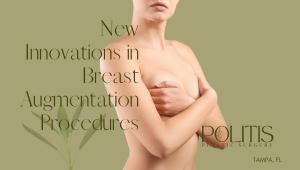New Innovations in Breast Augmentation Procedures


 The decision to undergo a breast augmentation surgery is one that should be well researched and thoroughly discussed with a board-certified plastic surgeon. Breast augmentation is a cosmetic surgical procedure in which the size and/or shape of a woman’s breasts are surgically altered to improve the appearance of her bust line. This can be done through fat transfer, tissue expansion, or implants. With new advancements in technology, there have been some exciting new developments in the various breast augmentation procedures. This article will provide an overview of the different types of breast augmentation procedures and important considerations for post-surgery recovery.
The decision to undergo a breast augmentation surgery is one that should be well researched and thoroughly discussed with a board-certified plastic surgeon. Breast augmentation is a cosmetic surgical procedure in which the size and/or shape of a woman’s breasts are surgically altered to improve the appearance of her bust line. This can be done through fat transfer, tissue expansion, or implants. With new advancements in technology, there have been some exciting new developments in the various breast augmentation procedures. This article will provide an overview of the different types of breast augmentation procedures and important considerations for post-surgery recovery.
Types of Breast Augmentation
Fat Transfer
Fat transfer is a type of breast augmentation which involves the transfer of fat cells from one area of the body to the breast area. This can help to restore volume and create a natural look and feel. The benefits of fat transfer is that it is generally considered a safer option than implants because the body is not exposed to any foreign objects. Additionally, the risk of complications such as infection and capsular contracture is much lower. However, the downside of fat transfer is that the results are not as long-lasting compared to the other options.
Tissue Expansion
Tissue expansion is another type of breast augmentation which involves the use of saline or silicone implants. With tissue expansion, saline or silicone implants are inserted between the breast and chest wall. The implants then stretch the skin and over time, the tissue of the breasts will expand to accommodate the implants. This gives a larger, fuller look. The benefits of tissue expansion is that the results tend to be more long-lasting than fat transfer and the risks are generally lower than with the other options.
Implants
Another type of breast augmentation is implants. This is the most commonly used method and involves the insertion of silicone or saline inserts into the breasts. The implants are designed to mimic the natural shape and size of a woman’s breasts. The main benefit of implants is that the results are more immediate compared to the other options. Additionally, the shape and size can be more closely controlled as well. The downside, however, is that there is a higher risk of complications that comes with the surgery.
Post-Surgery Recovery
Once the breast augmentation procedure is completed, it is important to follow the post-surgery instructions provided by the plastic surgeon. Depending on the type of procedure, the recovery timeline and follow-up care may vary. Generally, the recovery period is between one to three weeks. During this time, the patient should avoid certain activities such as lifting, pushing, or pulling and should follow the prescribed medications as directed. Additionally, post-op appointments are required to monitor the patient’s recovery and ensure that the implants are settling and healing properly.
Conclusion
Breast augmentation can improve the appearance of a woman’s bust line and provide a more balanced figure. There are a few different procedures available, each with their own benefits and risks. It is important that patients take the time to research the different options and discuss their concerns and goals with a board-certified plastic surgeon. A skilled plastic surgeon, such as Dr. Effie Politis of Politis Plastic Surgery in Tampa, FL, can help patients make an informed decision and guide them through the post-op recovery process.
Politis Plastic Surgery is a premier plastic surgery clinic in Tampa, FL headed by Dr. Effie Politis. The clinic offers a wide range of cosmetic surgery procedures and provides personalized care to each of their patients. With her extensive training and experience, Dr. Politis is committed to helping her clients achieve natural-looking results and the highest level of satisfaction. To learn more about the services offered at Politis Plastic Surgery, be sure to visit the clinic’s website or call for a free consultation today.
References: